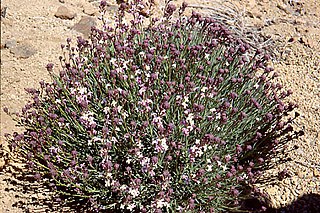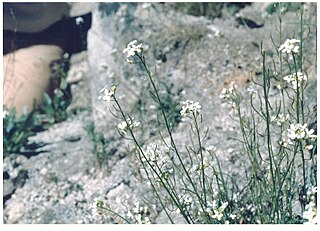
Brassicaceae or Cruciferae is a medium-sized and economically important family of flowering plants commonly known as the mustards, the crucifers, or the cabbage family. Most are herbaceous plants, while some are shrubs. The leaves are simple, lack stipules, and appear alternately on stems or in rosettes. The inflorescences are terminal and lack bracts. The flowers have four free sepals, four free alternating petals, two shorter free stamens and four longer free stamens. The fruit has seeds in rows, divided by a thin wall.

Arabidopsis (rockcress) is a genus in the family Brassicaceae. They are small flowering plants related to cabbage and mustard. This genus is of great interest since it contains thale cress, one of the model organisms used for studying plant biology and the first plant to have its entire genome sequenced. Changes in thale cress are easily observed, making it a very useful model.

Erysimum, or wallflower, is a genus of flowering plants in the cabbage family, Brassicaceae. It includes more than 150 species, both popular garden plants and many wild forms. The genus Cheiranthus is sometimes included here in whole or in part. Erysimum has since the early 21st century been ascribed to a monogeneric cruciferous tribe, Erysimeae, characterised by sessile, stellate (star-shaped) and/or malpighiaceous (two-sided) trichomes, yellow to orange flowers and multiseeded siliques.

Trichomes are fine outgrowths or appendages on plants, algae, lichens, and certain protists. They are of diverse structure and function. Examples are hairs, glandular hairs, scales, and papillae. A covering of any kind of hair on a plant is an indumentum, and the surface bearing them is said to be pubescent.

Metabolomics is the scientific study of chemical processes involving metabolites, the small molecule substrates, intermediates, and products of cell metabolism. Specifically, metabolomics is the "systematic study of the unique chemical fingerprints that specific cellular processes leave behind", the study of their small-molecule metabolite profiles. The metabolome represents the complete set of metabolites in a biological cell, tissue, organ, or organism, which are the end products of cellular processes. Messenger RNA (mRNA), gene expression data, and proteomic analyses reveal the set of gene products being produced in the cell, data that represents one aspect of cellular function. Conversely, metabolic profiling can give an instantaneous snapshot of the physiology of that cell, and thus, metabolomics provides a direct "functional readout of the physiological state" of an organism. There are indeed quantifiable correlations between the metabolome and the other cellular ensembles, which can be used to predict metabolite abundances in biological samples from, for example mRNA abundances. One of the ultimate challenges of systems biology is to integrate metabolomics with all other -omics information to provide a better understanding of cellular biology.

Brassica oleracea is a plant species from family Brassicaceae that includes many common cultivars used as vegetables, such as cabbage, broccoli, cauliflower, kale, Brussels sprouts, collard greens, Savoy cabbage, kohlrabi, and gai lan.
Glabrousness is the technical term for a lack of hair, down, setae, trichomes or other such covering. A glabrous surface may be a natural characteristic of all or part of a plant or animal, or be due to loss because of a physical condition, such as alopecia universalis in humans, which causes hair to fall out or not regrow.

Boechera (rockcress) is a genus of the family Brassicaceae. It was named after the Danish botanist Tyge W. Böcher (1909–1983), who was known for his research in alpine plants, including the mustards Draba and Boechera holboellii. According to recent molecular-based studies, Boechera is closely related to the genus Arabidopsis which also includes the widely known model plant Arabidopsis thaliana.

Quercus lyrata, the overcup oak, is an oak in the white oak group. The common name, overcup oak, refers to its acorns that are mostly enclosed within the acorn cup. It is native to lowland wetlands in the eastern and south-central United States, in all the coastal states from New Jersey to Texas, inland as far as Oklahoma, Missouri, and Illinois. There are historical reports of it growing in Iowa, but the species appears to have been extirpated there. It is a slow-growing tree that often takes 25 to 30 years to mature. It has an estimated lifespan of 400 years.

Ficus lyrata, commonly known as the fiddle-leaf fig, banjo fig, fiddle-leaved fig tree, lyre leaf fig tree, or lyre-leaved fig tree, is a species of plant in the mulberry and fig family Moraceae. It is native to western Africa, but is cultivated around the world as an ornamental plant. It has received the Royal Horticultural Society's Award of Garden Merit.

Myrosinase is a family of enzymes involved in plant defense against herbivores, specifically the mustard oil bomb. The three-dimensional structure has been elucidated and is available in the PDB.
Timing of CAB expression 1 is a protein that in Arabidopsis thaliana is encoded by the TOC1 gene. TOC1 is also known as two-component response regulator-like APRR1.
Arabidopsis arenicola, the Arctic rock-cress, is a plant species native to the northeastern part of North America. It has been reported from Greenland, Labrador, Nunavut, Northwest Territories, Québec, Ontario, Manitoba, and Saskatchewan. It grows on sandy or gravely beaches or stream banks at elevations below 1,500 metres (4,900 ft).
Metabolomic Pathway Analysis, shortened to MetPA, is a freely available, user-friendly web server to assist with the identification analysis and visualization of metabolic pathways using metabolomic data. MetPA makes use of advances originally developed for pathway analysis in microarray experiments and applies those principles and concepts to the analysis of metabolic pathways. For input, MetPA expects either a list of compound names or a metabolite concentration table with phenotypic labels. The list of compounds can include common names, HMDB IDs or KEGG IDs with one compound per row. Compound concentration tables must have samples in rows and compounds in columns. MetPA's output is a series of tables indicating which pathways are significantly enriched as well as a variety of graphs or pathway maps illustrating where and how certain pathways were enriched. MetPA's graphical output uses a colorful Google-Maps visualization system that allows simple, intuitive data exploration that lets users employ a computer mouse or track pad to select, drag and place images and to seamlessly zoom in and out. Users can explore MetPA's output using three different views or levels: 1) a metabolome view; 2) a pathway view; 3) a compound view.
Robert L. Last is a plant biochemical genomicist who studies metabolic processes that protect plants from the environment and produce products important for animal and human nutrition. His research has covered (1) production and breakdown of essential amino acids, (2) the synthesis and protective roles of Vitamin C and Vitamin E (tocopherols) as well as identification of mechanisms that protect photosystem II from damage, and (3) synthesis and biological functions of plant protective specialized metabolites. Four central questions are: (i) how are leaf and seed amino acids levels regulated, (ii.) what mechanisms protect and repair photosystem II from stress-induced damage, (iii.) how do plants produce protective metabolites in their glandular secreting trichomes (iv.) and what are the evolutionary mechanisms that contribute to the tremendous diversity of specialized metabolites that protect plants from insects and pathogens and are used as therapeutic agents.

Sexual selection in Arabidopsis thaliana is a mode of natural selection by which the flowering plant Arabidopsis thaliana selects mates to maximize reproductive success.

Erysimum collinum is a plant species in the family Brassicaceae. It is a member of the genus Erysimum, which includes between 150 and 350 species in the Northern Hemisphere.

Erysimum crepidifolium, the pale wallflower, is a plant species in the crucifer family, Brassicaceae. It is a member of the genus Erysimum, which includes between 150 and 350 species in the Northern Hemisphere.
Goodenia lyrata is a species of flowering plant in the family Goodeniaceae and is endemic to inland areas of Western Australia. It is a prostrate herb with densely hairy, lyrate leaves at the base of the plant, smaller leaves on the stem and racemes of yellow flowers.

Sandbergia is a genus of flowering plants belonging to the family Brassicaceae. They are also in the Boechereae Tribe.















